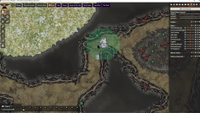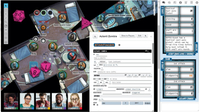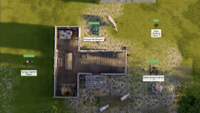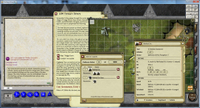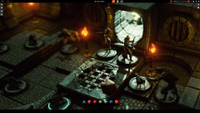While D&D has had a wild surge in popularity in recent years thanks to shows like Critical Role, D&D is not the only TTRPG. There are plenty of popular and fun TTRPGs to play, like Call of Cthulhu, Shadowrun and Blades in the Dark. A few TTRPGs I’m currently eyeing are The Witcher Role-Playing Game and the Altered Carbon Role Playing Game (I’m still grieving, Netflix). Have you heard about the D&D OGL controversy? Our friends at Gizmodo (opens in new tab) wrote a comprehensive breakdown on the topic that you should read if you’re a content creator in the TTRPG space. After you’ve picked which TTRPG to play with friends, you can determine which is the best virtual tabletop software for you.
What is the best virtual tabletop software?
There are quite a few great virtual tabletop programs out there, but finding the best one for your specific game is more important than simply using the most expensive one. My personal favorite is Foundry Virtual Tabletop due to its customizability and relatively affordable price. It also smoothly integrates with content from D&D Beyond, a website for buying D&D 5e books and creating characters, and I love the way it handles its music player. However, if you’re looking for free, easy-to-use software, try Roll20, a popular virtual tabletop software. If you’re looking for something more unconventional and don’t mind spending a bit of money, Tabletop Simulator is a great software to host your TTRPG games. Thanks to its 3-dimensional nature, it feels more engaging than your average 2D software. You can even hop into this game in VR. However, for something similar to Foundry but for free (to an extent), then go with Astral, which is a great virtual tabletop software that gives you access to a ridiculous number of rule sets. Those who like old-school TTRPG can try out Fantasy Grounds, a highly customizable albeit somewhat hard-to-use software. It can get pricier than the rest of the entries on this list, so keep that in mind. There are also plenty of virtual tabletop software apps that we didn’t get to mention on this list, like Tableplop and Let’s Role, which are also viable options.
- Foundry Virtual Tabletop
Foundry Virtual Tabletop is currently my go-to virtual tabletop for my own home game. It’s a super customizable web-based software that gives you access to almost everything you need to create and run a TTRPG game. You can easily import maps that you create as JPEGs and it’ll layer a usable grid over the top so players can move their characters around during combat or judge the time of travel over long distances. One of my favorite features is the ability to layer music on top of each other, so you can mix an atmospheric track with an actual musical track. Foundry also has an active community that imports rule systems and templates for many TTRPGs including D&D. There’s also some crossover with D&D Beyond, and as someone who’s heavily invested in that service, Foundry is even more appealing. To use Foundry, you have to buy a license, which is a one-time payment of $50. The best part is that none of your players have to pay to use it.
2. Roll20
Roll20 is arguably the most popular virtual tabletop software out there, and for good reason: it’s relatively easy to use and it’s free (kind of). Like Foundry, it is web-based so you don’t have to download anything (even as the GM). It’s also incredibly customizable and has built-in tools to easily run most TTRPGs. It doesn’t just focus on D&D either; Roll20 has rulesets for all kinds of games, including Pathfinder and Call of Cthulhu. Keep in mind that while Roll20 is free, all of the juicy stuff is locked behind its market. Through its marketplace, you can buy games and art, including maps, tokens, objects and more. If you don’t have a lot of money, Roll20 can be tough to get into if you want to go all-out. There are subscription tiers of $5 per month and $10 per month that give you access to features like larger upload storage and custom character sheets. However, you can easily run an adventure in Roll20 without all of the extra bits.
3. Tabletop Simulator
I’ve clocked 524 hours into Tabletop Simulator, so I can confidently say that I have experience using it. It can be the most engaging virtual tabletop software and the most annoying in the bunch. Unlike the rest, Tabletop Simulator exists within a 3-dimensional space. It isn’t inherently built to easily work with TTRPGs, so there’s some legwork you have to do and it takes a bit of getting used to. Fortunately, Tabletop Simulator has a very active community, and on top of setting any TTRPG you want, it’s an easy way to play virtually any popular board game. All you have to do is dive into the Steam workshop to look at the mods people have created for the game. It’ll take time to set up a game, but once you do, you can interact with 3D miniatures and even 3D maps. It’s a lot of work, but if you’re committed, Tabletop Simulator can easily be the best virtual tabletop software out there. However, the game does cost $20 and it must be purchased by each player, although you will find the game frequently on sale for $10 so it’s not an expensive investment.
- Astral
Astral is like a mash-up of Roll20 and Foundry VTT. It’s still web-based and runs on a similar model to Roll20 – it’s technically free, but there are subscription tiers as well as a marketplace. One of the unique features of Astral is its dynamic visual FX. It makes your game more engaging than using your average static battlemap. There are even tabs to keep track of initiative and a tab for quick creatures that you can pop – as a GM, this is ridiculously useful. Astral also gives you free access to a number of game systems, including D&D 5e, The Witcher Pen and Paper RPG and Vampire: The Masquerade. Of the virtual tabletop software apps, I found Astral was the easiest to not only set up a game on, but to start creating and run a session. Keep in mind that at the basic tier, you can only upload up to 1GB of content, which can run low quickly if you’re balancing high-res maps and waves of epic soundtracks.
5. Fantasy Grounds
Fantasy Grounds has been around for a long time, and unlike some of the virtual tabletop software on here, you have to download it. Out of all of my testing, I found it the most difficult virtual tabletop software to get into for several reasons. Firstly, absolutely nothing is free. There is a demo version for people to try out, but you can’t play with people unless you know someone who owns the $150 license. Secondly, it looks as old as it is, and for software first developed in 2004, that’s not a good thing. However, it is one of the few virtual tabletop software on this list with purchasable books built within its system. The software itself is still pretty customizable and presents a very retro RPG aesthetic, if that’s what you’re into. I’m not the biggest fan of Fantasy Grounds, but you can create some truly wild things with it.
6. TaleSpire
TaleSpire is a brand new three-dimensional virtual tabletop software completely built around TTRPGs. It’s like if Tabletop Simulator was made specifically for D&D and the genre of roleplaying games. The pros of TaleSpire is that you can be super creative with map building and your players will get the best possible vision of what’s happening around them. The con of TaleSpire is that all of the players need to own the game in order to play, and since it’s a $25 purchase, you’re taking a chance. However, the cheapest way to play is if the GM purchases a copy for themself and then stream their screen for their players. Overall, I’ve had a lot of fun messing around with TaleSpire. I haven’t run a session in it yet, but I plan to at some point. Even Dimension 20 has jumped on the TaleSpire bandwagon, with their new show, The Seven.
7. The RPG Engine
The RPG Engine (opens in new tab) is a relatively new virtual tabletop that lets you build a freeform 3-dimentional maps that can be exported to 2D. You can sculpt and paint the terrain around the map and fill the world with customizable characters and props. The space on the board seems a little small at first, but if you scale things down, you’ll realize that you have more space than you think. You’ll be able to loosely run combat within this virtual tabletop, but there aren’t any rules baked in for games like Call of Cthulhu or Dungeons & Dragons 5e. Additionally, map-making in this takes a lot of work, and while some creatives may love the challenge, the GMs that love to scramble at the last minute (aka me) won’t find too much use here. However, this tabletop is still in beta, so it’s entirely possible that there will be more procedurally generated options included for the GMs on the go.
